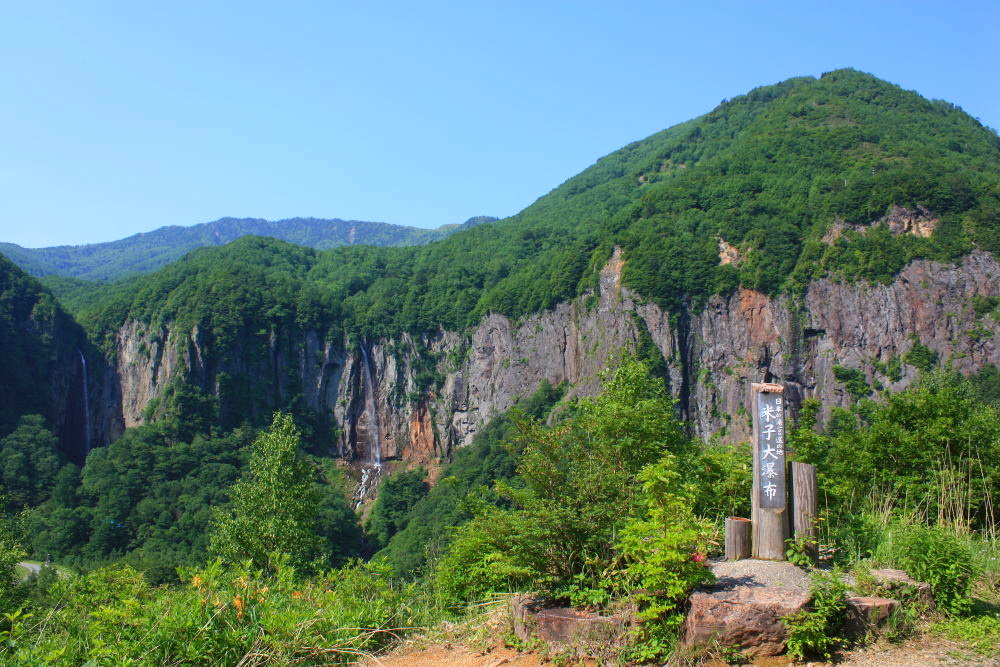History

Yonako Falls
Yonako Falls
Kenshin Uesugi
Uesugi Kenshin was the daimyo who ruled over Echigo (currently known as Niigata Prefecture) during the Sengoku Era. His mandate lasted from the year 1561 to the year 1578.
He was the 16th leader of the Yamanouchi-Uesugi clan.
He unified Echigo and ran several expeditions to the Kanto, Hokushin, and Horikuku areas.
One of the most remarkable warriors of his time, his godly war strategy gained him the names of "Godly Warrior" and "Echigo Dragon".
In the 4th year of the Eiroku Era (1561 a.D.), during the 4th Battle of Kawanakajima, Kenshin himself came to worship the Fudo-Myoo of our temple praying for victory to raise the morale of his army.
On his return from battle, he enshrined the statue of Fudo-Myoo as the main subject of worship in Ryutakusan Kawaranoin Nyorai Temple (now the Okuin of our temple), and he prayed for peace among the people of Kanto.
Kenshin renamed this temple "Yonako Takiyama Itokuin Fudoji", and the temple remains to this day.
Interestingly, in Joetsu City, in Niigata, there is a Fudo Temple (Taki-ji Fudo) near a 3m waterfall.
We can feel a strong connection at our temple, as the Bishamonten that Kenshin worshipped is enshrined nearby. Local people say that “there used to be a statue of Kenshin, but it has not returned since the battle of Kawanakajima."
Kenshin is the incarnation of Bishamontnen and the reason for his connection with our temple's Fudo-Myoo is that he was the only Sengoku daimyo that upon his arrival to the capital went to the imperial palace to greet the emperor and to offer the greetings of the Kanto administration.
The Muromachi shogunate awarded the Fudo-Myoo of the Guardian Buddha, which was treasured up to that point by the Ashikaga family, in particular the 13th Shogun, the Left Minister Ashikaga Yoshiteru, and the 20th head of the family. That Fudo-Myoo is the main entity of worship of our temple.
Lineage - The Sanada Clan
In the "Azuma Kagami", a chronicle compiled in the Kamakura Era, the foundation of our Okunoin (or inner sanctuary) is documented.
In the second year of the Yoro Era (718), Great Master Taicho's first disciple Kyosada enshrined Hakusan Daigongen and Azumayasan Daigongen as purification entities in the shrine at the foot of the waterfall. The local Buddha was the Eleven Faced Kannon.
This is the origin of our temple, and the reason High Priest Gyōki visited this sacred place.
Did you know that the powerful Sanada Clan worshipped Hakusan Gongen?
They considered Hakusan Gongen as their patron.
The two brothers Sanada Masayuki and Sanada Nobutsuna, who were regarded by Takeda Shingen as his eyes, used to serve as priests at the inner sanctuary at the foot of the waterfall.
The way Masayuki fought truly reflected that of Takeda Shingen, as he defeated Shogun Tokugawa Ieyasu and his son Hidetada twice in battle at Ueda Castle.
The Sanada Clan (in particular Sanada Nobushige) was recognized as the strongest army in Japan by Hosokawa Tadaoki, Uesugi Kagekatsu, Shimazu Yoshihiro, and Date Masamune.
The current chief priest and his wife descend from Masayuki's eldest son Sanada Nobuyuki and his second son Sanada Nobushige's lineage.
After hundreds of years from the two brothers' separation, their descendants are reunited. That's why our temple has two family crests, the Uesugi crest, and the Sanada Rokumonsen crest.
Why display two family crests? Wasn't the Sanada Clan part of the Takeda Clan?
Our entity of worship is Fudo-Myoo, Uesugi Kenshin's Buddha.
The Chief Priest descends from the Sanada Clan, and his wife descends from the Uesugi clan, and that is why we have these two crests.
The motto of our family is: "cling to life and live until the day you die".
